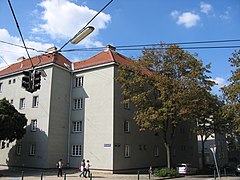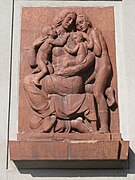Ettenreichgasse
| Ettenreichgasse | |
|---|---|
| Street in Vienna | |
| Basic data | |
| place | Vienna |
| District | Favoriten (10th district) |
| Created | 1875 |
| Connecting roads | Otto-Willmann-Gasse |
| Cross streets | Davidgasse , Schröttergasse, Gellertgasse, Inzersdorfer Straße, Angeligasse , Hardtmuthgasse, Troststraße , Ricarda-Huch-Weg, Dieselgasse, Grenzackerstraße |
| Places | Reumannplatz |
| Buildings | University of Education Vienna , HTL Vienna 10 |
| use | |
| User groups | Pedestrians , bicycle traffic , car traffic |
| Road design | one way street |
| Technical specifications | |
| Street length | approx. 1020 m |
The Ettenreichgasse located in the 10th Vienna district, favorites . It was named in 1875 after Josef Ettenreich , a master butcher who was able to thwart a knife attack on the Austrian Emperor Franz Josef in 1853 .
Location and characteristics
The Ettenreichgasse begins at Reumannplatz and climbs in a southerly direction to Grenzackerstraße. It is fully equipped with avenue trees and has a cycle path. For car traffic, it is a one-way street from Troststrasse to Reumannplatz. Between Troststrasse and Dieselgasse, it is a dead end for motorists, and then Ettenreichgasse becomes a pedestrian and cycle path as far as Grenzackerstrasse, as there is a large school center here . This path crosses Grenzackerstraße with Pernerstorfersteg and continues on the other side in Otto-Willmann-Gasse. The development between Reumannplatz and Inzersdorfer Straße largely dates back to around 1900, followed by other modern buildings. There is a mosque at number 38 .
Buildings
No. 1: Paula-Hof
The Paula-Hof dates from 1914 and is located on the corner of Reumannplatz. The side there is representative .
No. 21–23: Former city architect WFSommer
Here, in May 2010, the workshop of the former city architect WFSommer was demolished. The guild signs for bricklayers and carpenters were depicted on the facade and a bricklayer at the main gate on the left and a carpenter at work on the right. These were red-brown relief representations which were signed with "LS". From autumn 2010 to spring 2012 the ÖSW (Österreichisches Siedlungswerk Gemeinnützige Wohnungsaktiengesellschaft) built a residential building on this area.
No. 22: Ettenreich mosaic
At the modern house number 22 there is a two-part mosaic , which reminds of the namesake of the alley, Josef Ettenreich. The left side shows a portrait of the named person, the inscription introduces him. On the right side you can see the votive church , which was donated by the emperor as thanks for the surviving assassination attempt, the inscription here refers to the deed of Ettenreich.
No. 25–27: Former Sokol gym
Originally there was a factory building here, which Josef Vytiska converted into a gymnasium for the Czech Sokol association in 1933/34 . The elongated building with a flat roof had a plaster cut field with the image of a falcon (Sokol means falcon in German) on the entrance front. Around the year 2000 this building was torn down and replaced by a modern new residential building. Behind it the new Sokol gym was built on Angeligasse .
No. 41-43: GRG 10
At the beginning of the school center in Ettenreichgasse is a grammar school , which was built from 1958 to 1960 according to plans by the architect Wilhelm Hubatsch. From 2009 to 2011 a study of the hamsters living in the wild took place on the school premises . This animal species, which is already rare today, currently feels very comfortable in a human environment. At the school's sports field there, they can dig their structures and holes as they please, which is a noteworthy rarity in otherwise asphalted Vienna and is not disturbed by people.
No. 42–44: Former St. Josef family asylum
Since municipal housing construction in Vienna declined sharply in the 1930s due to the political and economic situation , so-called unemployment settlements were increasingly being built on the outskirts of the city, which were supposed to offer the numerous unemployed people looking for accommodation in a simple form . Following the example of the German National Socialist people's housing construction, seven residential complexes were built from 1935, which the Christian-Social City Administration called family asylums. These 830 apartments in total were made available to low-income and large families for a limited time only. Most of the time, however, it became a permanent home.
The aforementioned residential complex was named after Saint Joseph . The architect Franz Wiesmann built it in 1935/36 in simple, unadorned forms and, despite the limited resources available, tried to achieve a minimum of humanity in the design of the living space. The complex consists of 95 apartments in two courtyards, the corners on Troststrasse are set back as the only design element. Between 1991 and 1993 the residential complex was renovated .
On the side of Ettenreichgasse there is a large sculpture of Josef Heu on the house wall , which depicts Saint Joseph. During the National Socialist period, this figure had to give way to figures with the heroes of the time. After the war it was put back on the house. At that time, in 1951, a ceramic relief of Edmund Moiret's mother with children was created , which is on the side of Troststrasse.
The entire residential complex is under monument protection .
No. 45: Vienna University of Education
University of Education Vienna : In 1968 the buildings on Grenzackerstraße for the Federal Education Academy Ettenreichgasse were built according to plans by Karl Leber and Heinrich Matha. Compulsory school teachers and kindergarten teachers are trained here . An elementary school and a kindergarten, each with their own entrances, are connected to the training centers.
No. 54: Higher Technical College
HTL Wien 10 : On the other side of Ettenreichgasse, on Grenzackerstraße, there is the Higher Technical College.
literature
- Herbert Tschulk: Viennese district culture guide favorites . Jugend & Volk, Vienna 1985, ISBN 3-224-16255-4
- Dehio Handbook Vienna. X. to XIX. and XXI. to XXIII. District . Anton Schroll, Vienna 1996
Web links
Coordinates: 48 ° 10 ′ 7.3 " N , 16 ° 22 ′ 28.5" E










